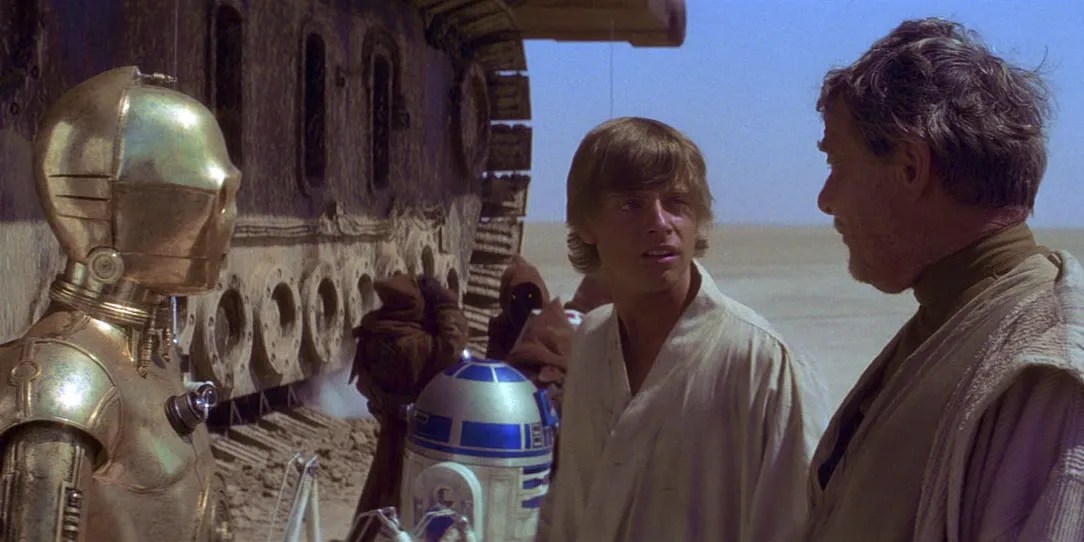The cultural influence ofStar Warsknows no bounds. George Lucas’ groundbreaking 1977 blockbuster markeda watershed moment in film history. An entire generation of filmmakers was inspired to pick up a camera and tell stories by the sense of wonder they felt watchingStar Warsas a kid. One specific way thatStar Warsinfluenced filmmaking – and science fiction in general – was the “used future” aesthetic of its unique production design.
AlthoughStar Warstakes placea long time ago in a galaxy far, far away, the rusty, lived-in aesthetic of Tatooine influenced the depictions of a “used future” inAlien,Blade Runner,Terminator,The Matrix, and a bunch of other sci-fi classics. By the late ‘70s, there was a generally accepted vision of the future in which everything was very clean and pristine. Everybody wore the same jumpsuits and the spaceships and buildings were all in tip-top, good-as-new condition. In a lot of these stories, everything was made of chrome (later parodied in a great existentialSpongeBobepisode).

RELATED:Star Wars: How Disney Can Learn From Its Mistakes For The Next Trilogy
In visualizing the Lars’ dusty moisture farm and the seedy criminal underbelly of Mos Eisley Spaceport and the iconic bucket-o’-bolts that is the Millennium Falcon, Lucas wanted to offer an alternative to the usual futuristic aesthetic by adding a layer of grime and wear-and-tear over everything in sight. Lucasdescribed this visual styleas “documentary fantasy,” or “fantasy combined with the feel of a documentary.” All the ships are covered in scratches and dents from years of use –the Falcon being a prime example– and the Rebel Alliance’s tech is as primitive as one would expect from a bare-bones militia. Jawas prowl the dunes of Tatooine in a dirty, banged-up Sandcrawler, picking up junked droids and selling them to farmers working on a barren wasteland.

This concept didn’t originate withStar Wars. It could previously be seen in 1969’sMoon Zero Two, 1972’sSilent Running(a big influence onWALL-E), and 1974’sDark Star. However, a lot of these movies cut costs by shooting in real locations like quarries and power plants; they didn’t build entire worlds from scratch likeStar Wars’ phenomenally talented production designers. And ifStar Warscan’t be credited with creating the “used future” aesthetic,its historic box office runcan sure be credited with popularizing it.
A couple of key filmmakers were inspired by this aspect ofStar Wars– namely, Sir Ridley Scott. When the success ofStar Warsled to a bunch of space movies and Scott was hired to directa haunted house movie in space, he applied these influences beautifully.Alienfollows the crew of the Nostromo, who are essentially futuristic truckers transporting cargo across space in a big, ugly rig. The Nostromo has the same grimy, well-worn, industrial feel ofStar Wars’ non-Imperial ships.
Scott took this influence a step further withhis next sci-fi movie,Blade Runner, which takes place in Los Angeles in the near future (although it’s now the past).Blade Runner’s futuristic L.A. has a thick cloud of pollution filling its skyline, trash piling up on the streets, flying cars stuck in traffic on congested airways, graffiti all over the towering skyscrapers – it’s a hauntingly beautiful portrait of urban decay. Scott took the prestigious Bradbury Building – one of the most overused shooting locations in film noir – and presented it in an entirely new way by dressing it up as a dilapidated dump. He added a canopy to the exterior, gave it twisting columns made out of Styrofoam, filled the interior with garbage, and blasted revolving spotlights and smoke machines. Incidentally,Blade Runnerended up returning the favor toStar Wars, as Scott’s depiction of a neon-drenched metropolis heavily inspired Lucas’ portrayal of the city-planet Coruscant in the prequels.
Another high-profileStar Warsfan, James Cameron, applied Lucas’ “used future” visuals to his own work. The flash-forwards in theTerminatormovies depict a post-Judgment Day world in whichthe machines have risen upand the human race is on the brink of extinction. Civilization has been reduced to rubble by a nuclear holocaust, the skies are filled with Skynet warships dropping bombs and decimating whatever remains, and the battlefields are filled with killer cyborgs looking to wipe out all human life on Earth. John Connor’s resistance fighters have been driven into a ramshackle existence hidden away from the Terminators, warming by dumpster fires.
It’s appropriate that Guillermo del Toro opened his epic-scale monsters-versus-robots smash-‘em-upPacific Rimwith aStar Warsreference – “Don’t get cocky” – because the influence ofStar Warscan be seen all over the movie’s aesthetic. The Jaeger suits are all a little worse for wear after countless kaiju beatdowns. Humanity is living in the ruins of civilized society and surviving on food rations. The computers need giant tapes to display information.Star Wars’ influence can also be seen inThe Matrix’s portrayal of the real world. Morpheus and his crew have unfathomable technologies, but since humanity has lost the war against its cybernetic overlords, they’re forced to live in a filthy, claustrophobic underground city.
Thanks to the success ofStar Wars, the “used future” has become a well-known trope, and it’s arguably become the go-to approach for depicting the future. Ironically, the classic portrayal of a monochromatic futuristic society has become a thing of the past.Star Wars’ “used future” style is evenparodied inSpaceballswhen Dark Helmet quips, “Even in the future, nothing works!”
MORE:Star Wars: Duel Of The Fates Would’ve Been A Better Finale Than The Rise Of Skywalker